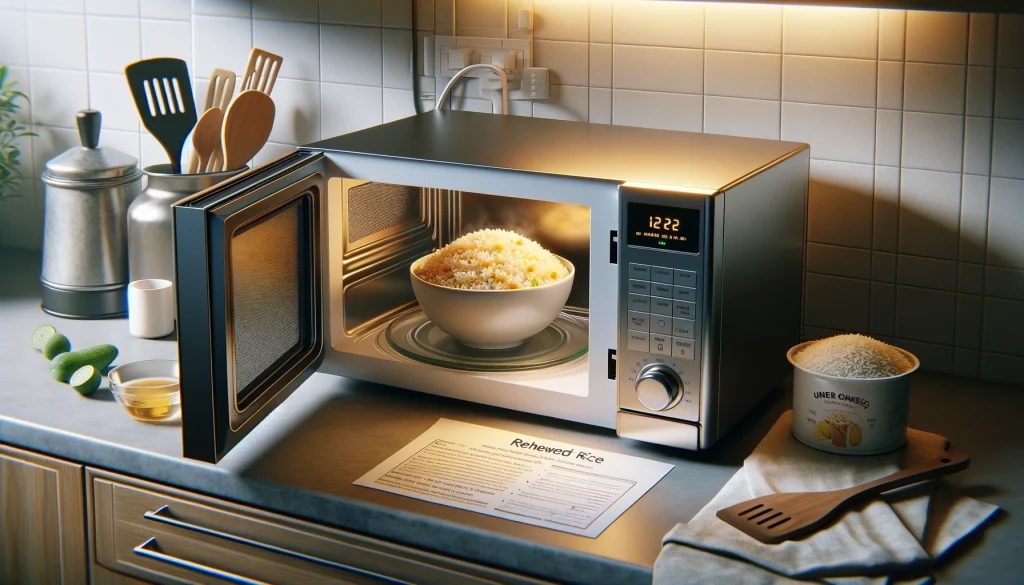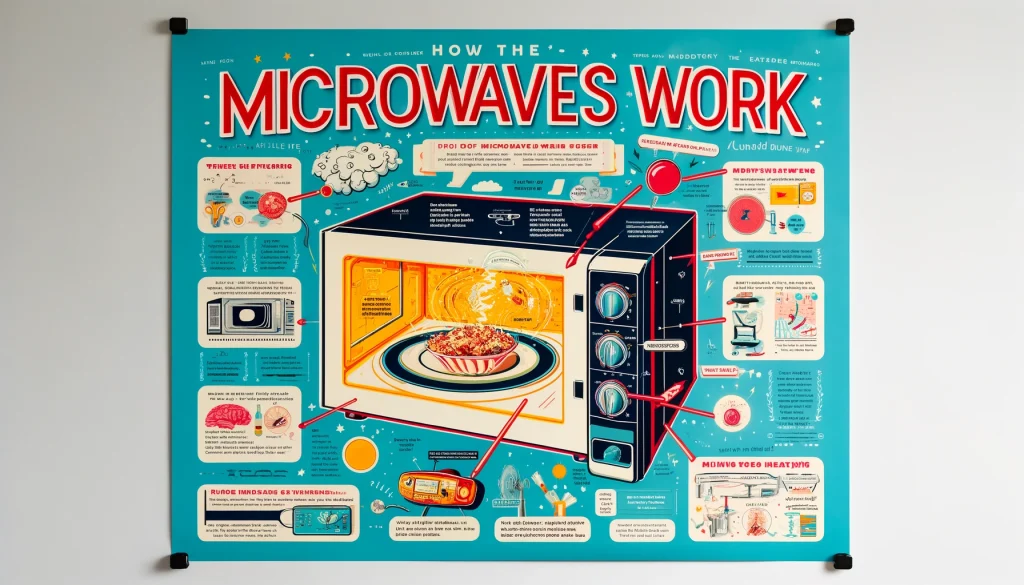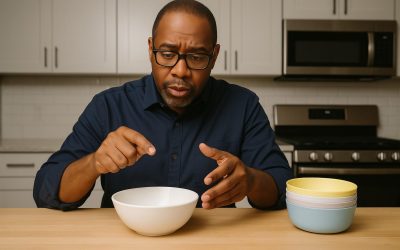As an Amazon Associate I earn from qualifying purchases.
Fried rice, with its delightful mix of flavors and ingredients, is a staple in many households and restaurants worldwide. It’s no wonder that it’s one of the most common leftovers we find in our refrigerators. However, the challenge arises when we want to enjoy that same deliciousness the next day. Microwaving, known for its convenience and speed, often emerges as the go-to method for reheating. But is there more to it than just pressing a few buttons? This article delves deep into the art and science of reheating fried rice in the microwave, ensuring that every bite you take feels as fresh and flavorful as when it was first cooked. Whether you’re a novice to the microwave world or a seasoned pro, this guide promises insights that can elevate your reheating game. Join us as we unravel the steps, tips, and precautions to make your leftover fried rice experience nothing short of perfect.
The Versatility of Fried Rice
Fried rice, a beloved staple in many cultures worldwide, is often celebrated for its adaptability and flavor-packed nature. It epitomizes the essence of culinary ingenuity, as it was historically concocted as a method to repurpose leftover rice and ingredients, turning them into a delightful dish. Over time, fried rice has evolved from a simple meal of convenience to a gastronomic delight with countless variations. Let’s delve deeper into what makes fried rice so versatile:
- A Canvas for Leftovers: At its core, fried rice was a clever way to prevent food wastage. Be it leftover vegetables, meats, or seafood, they can all find a place in a fried rice dish, giving the meal a new lease on life.
- Cultural Adaptations: From the spicy Kimchi fried rice of Korea to the aromatic Nasi Goreng of Indonesia, fried rice has been adapted to different cultures, each with its unique blend of ingredients and seasonings.
- Easily Customizable: Whether you prefer it vegetarian, loaded with meats, or a mix of both, fried rice allows for endless customizations. Dietary restrictions or personal preferences can easily be catered to.
- Meal for Any Time of the Day: While traditionally considered a lunch or dinner dish, variations like breakfast fried rice, incorporating ingredients like bacon and eggs, have emerged.
- Texture and Flavor Profile: The combination of soft rice grains, crunchy vegetables, and savory meats, all brought together with a blend of sauces and spices, offers a harmonious balance of texture and flavor in every bite.
- Perfect for Batch Cooking: Fried rice can be made in large quantities and stored for later, making it a go-to choice for meal preppers and busy households. It also retains its flavor and texture well, especially when reheated correctly.
- Pairs Well with Other Dishes: Fried rice can either be the star of the meal or a complement to other dishes. It pairs excellently with gravies, stews, or even grilled proteins.
In essence, the versatility of fried rice lies in its humble origins, adaptability, and the endless possibilities it offers to both chefs and home cooks. Whether it’s a quick meal on a busy day or a special dish for a festive occasion, fried rice’s adaptability ensures it has a place on every dining table.
Why Using a Microwave is a Popular Reheating Choice

The microwave oven, since its commercial introduction in the 20th century, has rapidly become an indispensable kitchen appliance in households worldwide. When it comes to reheating food, especially dishes like fried rice, the microwave is often the first choice for many, and for good reason:
- Speed and Convenience: Microwaves heat food much faster than traditional ovens or stovetops. This efficiency is especially appreciated in our fast-paced lives where waiting for an oven to preheat isn’t always feasible.
- Even Heating: With proper stirring and positioning, microwaves can reheat food relatively evenly. The microwave’s mechanism, which uses electromagnetic waves to agitate water molecules in food, ensures that the warmth permeates throughout the dish.
- Energy Efficiency: Microwaves use less energy compared to conventional ovens. They heat only the food, not the whole oven space, leading to quicker and more energy-efficient reheating.
- Less Cleanup: Food can be reheated directly in its storage container (provided it’s microwave-safe), reducing the need for additional pots and pans. This translates to fewer dishes to wash.
- Retains Moisture: When used with a covering or a lid, microwaves can trap steam and moisture, preventing dishes like fried rice from drying out during the reheating process.
- Space-Saving: Given their compact size compared to traditional ovens, microwaves are a boon for smaller kitchens or for those without access to a full kitchen setup.
- Versatility: Beyond reheating, microwaves are also used for defrosting, cooking, and even baking certain dishes. Their multipurpose nature adds to their appeal.
- Safety: Unlike open flames on a stovetop, there’s no direct fire risk with microwaves. Additionally, many modern microwaves come with safety features, including child locks and auto-off timers.
While the microwave offers numerous advantages, it’s essential to use it correctly. Especially with dishes like fried rice, where preserving texture and flavor is crucial, knowing the right reheating techniques can make all the difference. In the end, the microwave’s popularity as a reheating tool lies in its blend of convenience, efficiency, and versatility, making it a staple in modern-day kitchens.
Understanding Microwaves and How They Work

Microwave ovens, often simply referred to as “microwaves,” are a marvel of modern kitchen technology. At their core, they utilize electromagnetic radiation to cook or reheat food, but the process is a bit more intricate than it sounds. Here’s a deeper look into how microwaves operate:
- The Nature of Microwaves: Microwaves are a type of electromagnetic radiation, similar to radio waves but shorter in wavelength. They fall between infrared radiation and radio waves on the electromagnetic spectrum.
- Generation of Microwaves: Inside the microwave oven, there’s a device called a magnetron. When electricity passes through this magnetron, it produces microwaves.
- How Microwaves Cook Food: The microwaves produced by the magnetron penetrate the outer layers of food. The water molecules inside the food absorb these waves, which causes them to agitate and produce heat. This heat then cooks or reheats the food from the inside out.
- Even Cooking: To ensure that the microwaves cook food evenly, a turntable rotates the food, and stirrer blades help distribute the microwaves uniformly throughout the oven.
- Safety Mechanisms: The metal walls of the microwave oven, along with a metal mesh on the door, act as a Faraday cage, ensuring that the microwaves do not escape the oven and harm users. When the door opens, the microwave generation stops immediately, ensuring safety.
- Adjustable Power Levels: Most microwave ovens allow users to adjust the power levels. Lower power levels mean the magnetron is on less of the time and is interspersed with “off” periods. This is especially useful for delicate tasks like defrosting or for foods that might overcook easily.
- Efficiency: Because microwaves specifically target water molecules (and to a lesser extent, fats and sugars), they can cook food more quickly than conventional methods that require heating large volumes of air or water.
- Selective Cooking: Some foods contain more water than others. This is why, in a microwave, these moist areas might cook faster than drier areas. It’s also the reason why some parts of a dish might become very hot while other parts remain cooler.
Understanding the mechanism of microwaves can help users optimize their use, ensuring food is reheated or cooked efficiently, safely, and deliciously. Moreover, with knowledge of how a microwave works, one can more effectively troubleshoot issues and better grasp why certain foods behave the way they do when microwaved.
Basic Principles of Microwave Cooking
Microwave cooking, while speedy and convenient, has its unique set of principles that differentiate it from traditional cooking methods. Here’s a look at the foundational elements of microwave cooking:
- Microwave Interaction with Molecules: Microwaves target water, fat, and sugar molecules in food. When these molecules absorb microwave energy, they vibrate and produce heat, leading to cooking or reheating.
- Penetration Depth: Microwaves generally penetrate food up to an inch or so. Beyond that, the heat is conducted inwards, similar to conventional cooking. This is why thick foods may not always cook as evenly or may require stirring or turning partway through cooking.
- Edge Cooking: Microwaves cook the outer layers of food more quickly than the inner parts. This can result in the edges of dishes becoming overcooked if not monitored.
- Standing Time: After microwave cooking, it’s often recommended to let the food stand for a few minutes. This allows heat to conduct further into the food, ensuring even cooking, especially for larger or denser items.
- Covering Food: Covering food with a microwave-safe lid or wrap retains moisture, cooks food faster, and reduces splattering. It also facilitates steaming, which can be beneficial for certain foods.
- Turntable Importance: The rotating turntable in most microwaves ensures that food cooks more uniformly. It’s essential to ensure it’s functioning correctly and isn’t impeded.
- Power Level Adjustments: Microwaves usually offer adjustable power settings. Lower power levels are achieved by cycling the magnetron on and off, which is ideal for delicate tasks or foods that need gentle heating.
- Microwave-Safe Containers: Not all materials are safe for microwave use. Some can warp, melt, or even release harmful substances when heated. Always use containers labeled as microwave-safe.
- Size and Shape Matter: Smaller food pieces cook faster than larger ones. Similarly, round dishes cook more evenly than square or rectangular ones, as corners tend to receive more microwave energy and can overcook.
- Uneven Cooking: If food isn’t arranged correctly or is too dense, microwaves might not cook it uniformly. Stirring food or rearranging it halfway through cooking can mitigate this.
- Avoiding Metal: Metal reflects microwaves, which can cause uneven cooking and might even damage the microwave or start a fire. Never use metal utensils or containers in a microwave.
- Cooking from Frozen: Microwaves can directly cook frozen food. However, it might take longer, and the results can be uneven compared to thawed or fresh ingredients.
By grasping these basic principles, microwave users can better harness the device’s capabilities and achieve optimal results, whether they’re merely reheating leftovers or attempting more intricate culinary feats.
Why Microwaves are Suitable for Reheating
Microwave ovens have become a staple in kitchens around the world, particularly for reheating food. Their inherent design and operational principles make them especially apt for this purpose. Here’s why microwaves excel at reheating:
- Speed: One of the primary advantages of using a microwave is its ability to reheat food quickly. Unlike conventional ovens which require preheating, microwaves begin heating food instantly, saving both time and energy.
- Efficiency: Microwaves directly target water, fat, and sugar molecules in food, leading to rapid heating from the inside out. Traditional methods heat the air or medium around the food, which then heats the food itself—a slower and less direct process.
- Uniform Heating: When used correctly, with periodic stirring or turning, microwaves can heat food uniformly. The rotating turntable found in most microwave ovens also aids in ensuring even heating.
- Moisture Retention: When food is covered while reheating in a microwave, it retains more moisture. This is because the microwave can trap steam, preventing dishes like soups, stews, or rice from drying out.
- Energy Saving: Microwaving is energy-efficient, especially for reheating. It uses less energy than heating up a large conventional oven or stovetop, making it both eco-friendly and cost-effective.
- Flexibility with Portions: Microwaves allow you to easily reheat specific portions, whether it’s a single plate or a larger batch. This flexibility ensures that you only heat what you intend to consume.
- Safety: Microwaves eliminate the need to handle hot pots, pans, or oven trays. This reduces the risk of burns or other kitchen accidents. Additionally, many microwaves come with safety features like child locks.
- Less Cleanup: With the microwave, you can often reheat food in the same container it was stored in (if it’s microwave-safe), reducing the number of dishes to wash.
- Preservation of Nutrients: Since microwaving usually reheats food faster and at lower temperatures than other methods, it can help retain more of certain heat-sensitive nutrients.
- Adaptability: Modern microwaves come with various settings and modes, allowing users to choose the best reheating method for different types of food. Some even have sensor reheating options that adjust time and power based on the moisture released from the food.
In summary, the microwave oven’s speed, efficiency, and convenience make it an excellent tool for reheating a wide range of foods. When used correctly, it can restore leftovers to a quality closely resembling their freshly-cooked state.
Step-by-Step Guide to Reheating Fried Rice in a Microwave
Reheating fried rice in a microwave is quick and convenient. However, to ensure that it retains its texture and flavor, it’s important to follow the right steps. Here’s a step-by-step guide to do it:
- Check the Container: Before you begin, ensure that the container you’re using is microwave-safe. Plastic containers that aren’t microwave-safe can warp or release chemicals. Glass or ceramic containers are generally safe bets.
- Transfer the Rice: If the fried rice was refrigerated in a non-microwave-safe container, transfer it to one that is safe. Spread the rice out evenly so it can heat uniformly.
- Moisten the Rice: Fried rice can dry out in the refrigerator. To reintroduce some moisture, sprinkle a few drops of water over the rice. You don’t need much—just enough to create a bit of steam.
- Cover the Rice: Place a microwave-safe lid or plastic wrap over the container but leave a small gap or vent. This allows steam to escape, preventing the lid from popping off or the wrap from inflating too much.
- Set the Microwave: Start by setting the microwave to medium power. This ensures that the rice reheats evenly without becoming overly dry or sticky.
- Reheat: Microwave the rice on medium power for about 1-2 minutes. The exact time will depend on the microwave’s wattage and the amount of rice you’re reheating.
- Stir and Check: After the initial reheating time, carefully remove the container (it will be hot), and stir the rice. This helps redistribute heat and ensures even reheating. Check the temperature of the rice. If it’s not hot enough, continue microwaving in 30-second intervals, stirring between each, until it’s adequately warmed.
- Serve and Enjoy: Once the rice is evenly reheated, transfer it to a plate, garnish if desired, and enjoy!
Tips:
- If the rice is particularly dry, consider adding a splash of soy sauce or broth for added moisture and flavor during the reheating process.
- Always be cautious when removing covers from hot food in the microwave. Steam can build up and could burn you when released.
By following these steps, you’ll ensure that your fried rice is reheated evenly and retains its original flavor and texture, making it just as enjoyable as when it was first cooked.
Preparing the Fried Rice for Reheating
Properly storing and preparing your fried rice for reheating can make a significant difference in the final taste and texture. Here are some steps and tips to ensure the best results:
- Cooling the Fried Rice: If you’ve just cooked a batch of fried rice, or have leftovers from a meal, make sure to let the rice cool to room temperature before storing it. This will prevent the rice from becoming overly mushy due to residual steam.
- Choosing the Right Container: Use airtight containers to store fried rice. This will help preserve its freshness and prevent it from absorbing any odors from the refrigerator. Dividing the rice into portion-sized containers can also be handy for quick individual meals.
- Storing: Place the fried rice in the refrigerator within two hours of cooking to prevent bacterial growth. Properly stored, it can last 3-4 days.
- Avoiding Compaction: When placing the rice in a container, don’t press down too hard, as compacting the rice can make it dense and less pleasant when reheated.
- Adding Moisture: Refrigeration can dry out fried rice. Before reheating, sprinkle a little water over the rice to reintroduce some moisture. If you’re planning in advance, you can also store a small, microwave-safe cup of water alongside the rice in the refrigerator to boost humidity.
- Add-ins and Toppings: If your fried rice contains toppings or mix-ins like scrambled eggs, green onions, or crispy items, consider storing them separately and mixing them in after reheating. This ensures that ingredients retain their intended texture.
- Safety Check: Before reheating, give your fried rice a quick check. If it smells off or if there’s any mold, it’s best to discard it.
- Reheating Portions: Only reheat the amount of fried rice you plan to consume. Repeatedly reheating and cooling rice can degrade its quality and might increase the risk of foodborne illnesses.
Tips:
- While water is the most common moisture added, you can also sprinkle on a little broth, soy sauce, or sesame oil for added flavor.
- If you’re freezing fried rice for longer storage, reheating might take a bit longer. It’s a good practice to thaw the rice in the refrigerator overnight before reheating.
Preparing your fried rice with these considerations in mind ensures that when it’s time to reheat, the rice retains its original flavor and texture as closely as possible. Proper preparation is key to making leftovers feel like a fresh meal.
Selecting the Appropriate Microwave Settings for Reheating Fried Rice
The microwave settings you choose play a crucial role in ensuring your fried rice is reheated evenly without being overcooked or drying out. Here’s a guide to selecting the appropriate microwave settings:
Power Level:
- Medium Power (50-60%): This is ideal for reheating fried rice. Reheating on full power can sometimes cook the rice further, making it dry or rubbery. A medium setting allows the rice to warm up more gently and evenly.
- Defrost (30%): If you’re thawing frozen fried rice, start with the defrost setting before moving to medium power.
Time:
- Start with an initial 1-2 minutes for a single portion of fried rice. The exact time might vary depending on your microwave’s wattage and the quantity of rice.
- After the initial time, stir the rice and check its temperature. If it’s not hot enough, continue reheating in 30-second intervals, stirring in between, until it’s thoroughly warmed.
Turntable:
- Ensure the turntable is functioning and not obstructed. This ensures the rice is heated evenly as the microwave distributes its energy more uniformly when the food rotates.
Sensor Reheat:
- Some modern microwaves come with a sensor reheating function. This feature detects the level of humidity released from the food and adjusts the time and power accordingly. If your microwave has this function, it can be a handy way to reheat fried rice without the guesswork.
Use Microwave-Safe Containers:
- Always ensure you’re using microwave-safe containers. Avoid metals, as they can cause arcing and damage the microwave. Glass, ceramics, and some plastics are typically safe.
Covering the Rice:
- Use a microwave-safe lid or vented plastic wrap to cover the rice. This retains moisture and ensures even heating. Make sure there’s a small gap or vent to let out steam and prevent any potential bursting or popping.
Standing Time:
- After reheating, let the rice stand for a minute or two in the microwave. This allows the heat to distribute more evenly throughout the rice.
Tips:
- Always keep an eye on the rice while reheating. Different microwaves can have varying levels of power, and what takes one microwave 2 minutes might take another microwave only 1 minute.
- Remember that reheated rice should only be consumed if it reaches an internal temperature of at least 165°F (74°C) to ensure safety.
By selecting the right microwave settings, you can ensure your fried rice is as close to its original taste and texture as possible. Proper reheating can make all the difference in enjoying leftovers.
Duration and Temperature Considerations for Reheating Fried Rice in a Microwave
When reheating fried rice in a microwave, it’s essential to consider both the duration and temperature to achieve optimal results. These considerations will help prevent overcooking, drying out, or unevenly heating the rice.
Duration:
- Single Portion: For a typical single-serving portion of fried rice, start with 1-2 minutes on medium power. The exact duration will depend on the microwave’s wattage and the amount of rice you have.
- Larger Quantities: For larger batches, you might need to increase the time. It’s a good practice to heat in intervals, stirring in between, to ensure even reheating.
- Frozen Fried Rice: If you’re reheating rice straight from the freezer, it will take longer. Start by defrosting it on a low setting, then increase to medium power for reheating.
Temperature:
- Internal Temperature: The USDA recommends reheating leftovers to an internal temperature of 165°F (74°C) to ensure they’re safe to eat. Using a food thermometer can help determine when the rice has reached this temperature.
- Microwave Power Level: Instead of using the microwave’s highest setting, which can quickly overcook the rice, use a medium power (around 50-60%) to gently and evenly reheat the fried rice.
Moisture Retention:
- To avoid drying out the rice, sprinkle a little water over it before reheating. This adds moisture, which turns into steam during the heating process, keeping the rice fluffy.
Even Heating:
- Stir the rice halfway through the reheating process. This helps in redistributing the heat and ensures the rice heats evenly.
- If using a microwave without a rotating turntable, consider manually rotating the dish a few times during the reheating process.
Safety Precautions:
- Only reheat rice once. Repeatedly reheating and cooling rice can lead to foodborne illnesses.
- Consume reheated rice promptly and avoid letting it sit out at room temperature for extended periods.
Tips:
- If you’re unsure about the duration needed, always start with a shorter time and add more as necessary. It’s better to underheat and add more time than to overheat and overcook the rice.
- If the rice seems too dry even after adding water, a splash of soy sauce or chicken/vegetable broth can enhance both moisture and flavor.
By paying attention to the duration and temperature considerations, you can ensure that your fried rice remains flavorful and retains its desired texture, making leftovers just as delightful as the original meal.
Safety Precautions to Keep in Mind When Reheating Fried Rice in a Microwave
Reheating fried rice or any leftover food in a microwave is convenient, but it’s vital to ensure safety to avoid any potential health risks. Here are some crucial safety precautions to keep in mind:
Reheat Only Once:
- Always reheat rice (or any food) only once. Reheating multiple times can lead to uneven temperatures, making it a breeding ground for harmful bacteria.
Achieve the Right Temperature:
- Ensure that the reheated fried rice reaches an internal temperature of at least 165°F (74°C). Using a food thermometer can help you verify this. This temperature ensures that most harmful bacteria are killed.
Use Microwave-Safe Containers:
- Always use containers labeled as “microwave-safe” when reheating food in the microwave. Avoid using metal containers or foil, as they can cause arcing, potentially damaging your microwave or causing a fire.
Avoid Plastic Containers Unless Specified:
- Not all plastics are microwave safe. Some can melt or release harmful chemicals when heated. Always use containers that are specifically labeled as microwave-safe.
Cover, But Vent:
- While it’s a good practice to cover the rice to retain moisture and promote even heating, ensure there’s a vent or gap for steam to escape to prevent the cover from popping off or the container from bursting.
Stir for Even Heating:
- Always stir the rice halfway through reheating to ensure even heating. Microwaves can heat food unevenly, leading to “hot spots” that can burn you.
Consume Promptly:
- After reheating, consume the fried rice promptly. Don’t let it sit out at room temperature for long, as this can promote bacterial growth.
Storage:
- Ensure that the fried rice was stored properly before reheating. It should have been refrigerated within two hours of being cooked and consumed within 3-4 days of storage.
Check for Spoilage:
- Before reheating, always check the fried rice for any signs of spoilage. If it smells off, appears moldy, or has an unusual texture, it’s best to discard it.
Cooling Before Refrigeration:
- If you’ve cooked a fresh batch of fried rice and plan to store it, let it cool to room temperature (but not for more than two hours) before refrigerating. This prevents excess moisture from building up, which can degrade the texture and increase the risk of bacterial growth.
Avoid Repeated Cooling and Heating:
- If you take out rice from the fridge, reheat and don’t finish it, discard the leftovers. Repeated cooling and heating amplify the chances of bacterial growth.
Tips:
- When in doubt, always prioritize safety. If you’re unsure about the freshness or safety of the rice, it’s better to err on the side of caution and discard it.
- Remember, rice, particularly when left at room temperature, is a potential breeding ground for Bacillus cereus, a bacteria that can cause food poisoning.
Adhering to these safety precautions ensures not only the best flavor and texture of your reheated fried rice but also minimizes potential health risks. Proper reheating practices contribute to a safe and enjoyable meal experience.
Common Mistakes to Avoid When Reheating Fried Rice in a Microwave
Reheating fried rice in the microwave might seem like a straightforward task, but there are several mistakes people commonly make. Avoiding these can result in a more evenly reheated dish that retains its flavor and texture:
Not Using a Microwave-Safe Container:
- Always ensure that the container you’re using is labeled “microwave-safe.” Using inappropriate containers can lead to melting, warping, or even releasing harmful chemicals into the food.
Skipping the Moisture:
- Fried rice can dry out when stored. Not adding a sprinkle of water or a damp paper towel over the rice before microwaving can result in dry and hard rice. The added moisture helps in steam generation which makes the rice fluffy.
Setting the Microwave on High Power:
- Microwaving fried rice on the highest power setting can lead to uneven heating and overcooking. It’s often better to reheat at a medium power level for a slightly longer duration to ensure even and gentle reheating.
Not Stirring Midway:
- One common oversight is failing to pause and stir the rice halfway through the reheating process. This step ensures that the rice heats evenly, reducing cold spots.
Overloading the Microwave:
- Trying to reheat a large quantity of fried rice at once can lead to uneven results. It’s often better to divide it into smaller portions and reheat each separately.
Not Checking the Temperature:
- Simply feeling the outside of the container isn’t a reliable way to determine if the rice has heated thoroughly. Always stir and taste-test (carefully!) to ensure the rice is evenly heated throughout.
Reheating Multiple Times:
- It’s a common mistake to reheat rice, let it cool, and then reheat it again. This not only degrades the rice’s texture but also increases the risk of bacterial growth.
Ignoring the Rice’s Condition:
- If fried rice has been left out of the refrigerator for an extended period or is past its prime, reheating won’t make it safe to eat. Always check the rice’s condition and smell before reheating.
Skipping the Cover:
- Not covering the rice can lead to splatters and uneven heating. While it’s essential to cover, ensure there’s a small vent or gap for steam to escape.
Assuming All Microwaves Work the Same:
- Different microwaves have varying power levels and wattages. What works in one microwave might not work the same in another. Always adjust based on your microwave’s specifications and observe the rice during reheating.
Not Letting the Rice Rest:
- After reheating, it’s a good idea to let the rice sit for a minute or two inside the microwave. This allows the residual heat to distribute evenly throughout the rice.
By avoiding these common mistakes, you can ensure that your reheated fried rice is not only safe to eat but also retains its delightful taste and texture, making it just as enjoyable as when it was freshly made.
Frequently Asked Questions (FAQ’s)
Common Questions and Answers on How to Reheat Fried Rice in a Microwave
Q: How long should I microwave fried rice for reheating?
A: Typically, for a single serving of fried rice, reheating for about 2-3 minutes on medium power should suffice. However, the exact time might vary based on your microwave’s wattage and the quantity of rice. Always ensure it’s evenly heated throughout before consuming.
Q: Can I reheat fried rice more than once?
A: It’s not advisable to reheat fried rice (or any leftover food) multiple times, as this increases the risk of bacterial growth. Always reheat only the portion you plan to consume immediately.
Q: Why is my reheated rice dry and hard?
A: Fried rice can lose moisture during storage. Sprinkle some water or place a damp paper towel over the rice before microwaving to add moisture and prevent it from drying out.
Q: Is it safe to reheat fried rice in plastic containers?
A: Only if the container is labeled as “microwave-safe.” Not all plastics can handle microwave heat, and some might release harmful chemicals when heated.
Q: How do I know if my fried rice is still good for reheating?
A: Check for any off-putting smells, mold, or unusual textures. If the rice has been stored in the refrigerator and consumed within 3-4 days, it should generally be safe. However, always use your judgment and when in doubt, discard the rice.
Q: Can I add ingredients when reheating fried rice in the microwave?
A: Yes, you can add fresh veggies, proteins, or seasonings. However, remember that adding cold ingredients might increase the reheating time. Ensure everything is heated through before consuming.
Q: Why is there a lot of steam or condensation when I reheat rice?
A: Steam is a result of the moisture in the rice getting heated. Using a vented cover or loosely placing a lid can help release the steam and prevent excessive condensation.
Q: Is microwaving the best way to reheat fried rice?
A: Microwaving is certainly the quickest and most convenient way, but there are other methods like using a skillet or oven that might retain the rice’s texture better. The best method often depends on personal preference and the tools at hand.
Q: Can I microwave fried rice directly in its takeaway container?
A: Only if the container is labeled microwave-safe. Many takeaway containers, especially plastic or foam ones, aren’t suitable for microwaving. It’s safer to transfer the rice to a microwave-safe dish.
Q: My microwave tends to heat unevenly. Any tips?
A: Try reducing the power setting and increasing the heating time. Also, stirring the rice halfway through reheating can promote even heating.
Q: How does the microwave’s wattage affect the reheating process of fried rice?
A: The microwave’s wattage represents its power. A higher wattage microwave will heat food faster than a lower one. For fried rice, this means you may need to adjust the reheating time based on your microwave’s wattage. If you have a high-wattage microwave, you might need less time, while a lower wattage one might require a bit more time.
Q: Why does sprinkling water on the rice before microwaving help in reheating?
A: The water creates steam when heated, which helps to moisturize the rice grains. This prevents the rice from drying out and helps restore its original texture, making it fluffy and moist.
Q: Can the microwave cause any nutritional loss when reheating fried rice?
A: While any cooking method can cause a slight loss of nutrients, microwaving is actually one of the methods that retains most of the food’s nutrients. This is because microwaving typically requires shorter cooking times and minimal water, thus preserving more vitamins and minerals.
Q: How does the microwave reheat food, especially fried rice, on a molecular level?
A: Microwaves work by emitting electromagnetic waves that target water molecules in food. These waves cause the water molecules to vibrate rapidly, generating heat through friction. This heat then spreads throughout the food, like fried rice, reheating it from the inside out.
Q: Is it better to use the “defrost” setting for reheating if I’m trying to be gentle with the rice?
A: Not necessarily. The “defrost” setting is designed to slowly and gently thaw frozen food. For reheating fried rice, it’s best to use a medium power setting to ensure even and thorough heating without overcooking or drying out the rice.
Q: What’s the significance of letting the rice rest after microwaving?
A: Letting the rice rest allows for the residual heat to distribute evenly throughout the rice. This ensures that all parts of the rice reach a uniform temperature and helps in achieving a better texture.
Q: Is there a difference in reheating freshly made fried rice versus day-old fried rice in the microwave?
A: Day-old fried rice tends to be drier than freshly made rice due to moisture loss during storage. You might need to add a bit more water when reheating day-old rice to reintroduce moisture and achieve a desirable texture.
Q: Are there any specific microwave-safe materials you’d recommend for reheating fried rice?
A: Glass and ceramic containers are excellent for reheating food in the microwave. They don’t absorb odors, are resistant to staining, and heat evenly. Just ensure they’re labeled “microwave-safe.”
Q: How can I prevent the rice from becoming too chewy or rubbery when reheating?
A: The key is to rehydrate the rice by adding a bit of water and avoiding overcooking. Using medium power and stirring midway can also help achieve a consistent texture.
Q: Why is it crucial to stir the fried rice halfway during reheating?
A: Microwaves can sometimes heat food unevenly. Stirring the rice ensures that the heat distributes more uniformly, preventing cold spots and promoting consistent reheating.
Understanding the nuances of microwaving can greatly enhance the outcome of reheated fried rice. Leveraging expert knowledge ensures that the rice retains its flavor and texture, making for a delightful meal even the next day.
Conclusion
Reviving the flavors of fried rice doesn’t have to be a complicated ordeal. The microwave, with its inherent efficiency and speed, offers a convenient solution. However, as we’ve learned, the key lies not just in using the microwave, but in using it right. By understanding the fundamentals of microwave cooking and applying tailored techniques for fried rice, we can ensure that our leftovers are neither dry nor lifeless, but instead, brimming with the same zest and aroma of freshly made fried rice. While microwaving might seem straightforward, the nuances we’ve discussed make all the difference. So, the next time you find yourself with a container of leftover fried rice, remember the insights from this guide. In just a few minutes, you’ll be savoring a dish that’s as delightful as it was the day before, all thanks to the magic of mindful microwaving.






